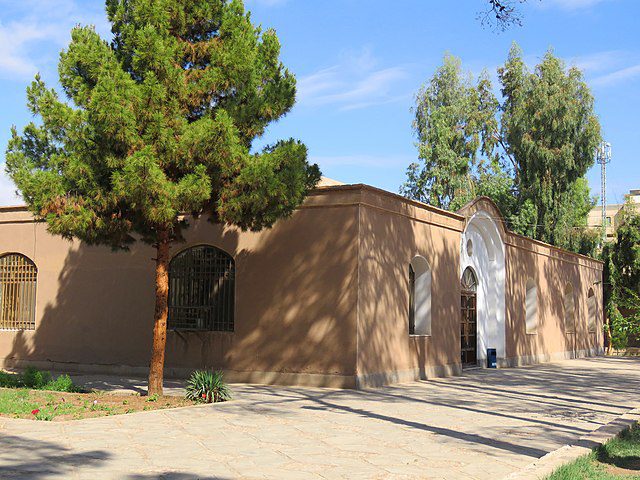Table of Contents
Kerman in a Glance
Kerman, the capital of Kerman Province, sits nestled among rocky hills, a city with a rich heritage. Its history stretches back centuries, and it stands tall at 5,738 feet above sea level, where cool breezes and sandstorms define the climate. The majority of its inhabitants are Persian-speaking Muslims, while a small Zoroastrian community adds diversity to the mix.
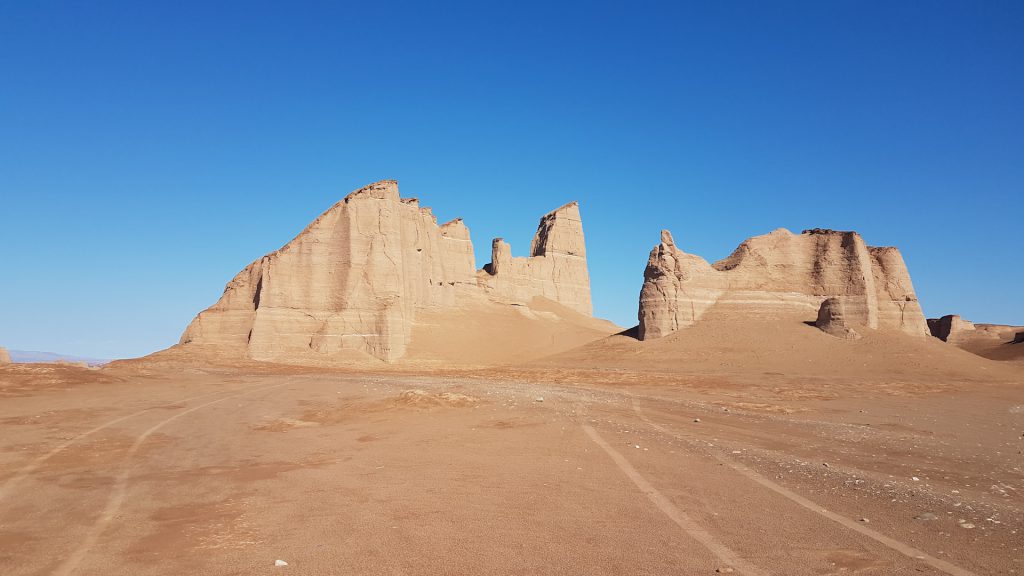
Kerman’s claim to fame is its centuries-old art of hand-woven carpets, renowned worldwide. The city once thrived on shawl making but has since shifted its focus to the mesmerizing craft of carpet weaving, especially in the Maahani suburb.
In the 1970s, the city’s industrial landscape expanded with the establishment of various facilities, including a cement plant, textile factory, and cold storage plant. To quench its thirst, the city relies on qanats, ancient underground aqueducts bringing water from the nearby hills. With well-connected roads to Bandar-Abbas and Mashhad, it not only offers a glimpse into Iranian culture but also serves as a gateway to explore Iran’s natural beauty.
Kerman History

Kerman was established as a protective stronghold named Veh-Ardashir by Ardashir I, the founder of the Sasanian Empire, during the 3rd century AD. Following the Battle of Nahāvand in 642, the city fell under Muslim control.
It was under the reign of Seljuk Turks in the 11th and 12th centuries A.D, but remained virtually independent and even conquered Oman and Fars. When Marco Polo visited the city in 1271, it had become a major trade emporium linking the Persian Gulf with Khorasan and Central Asia. The city was sacked many times by various invaders.
The city expanded rapidly during the Safavid Dynasty. Carpets and rugs were exported from here to England and Germany during this period. In 1793, Lotf Ali Khan defeated the Qajars and in 1794 captured the city. Soon, Agha Mohammad Khan besieged him here for six months. The present city was rebuilt in the nineteenth century to the northwest of the old city, but it did not recover until the twentieth century.
Kerman Geological Characteristics

For the Iranian Paleontologists, Kerman is considered a fossil paradise. Finding new dinosaur footprints in 2005 has now revealed new hopes for Paleontologists to understand better the history of this area.
Kerman Climate

Kerman, Iran tells a tale of two climates. Up north, it’s mild and dry, while the south and southeast sizzle with hot, somewhat humid weather.
In the summer, the sun blazes, making this city scorching and adventurous. But in winter, a cold hush takes over. It’s a place where nature switches between extreme heat and soothing cold, creating a fascinating contrast.
Kerman Pistachio

Kerman, Iran, is the ultimate pistachio paradise. Its vast pistachio orchards owe their fame to the perfect blend of climate and soil, yielding the most premium pistachios you’ll ever taste. Bathed in sunlight, these trees give rise to pistachios of unparalleled quality, ready to embark on a global culinary journey.
Here, pistachios don’t stay put; they travel the world. With a thriving export industry, these green treasures reach tables far and wide. The city’s commitment to quality doesn’t stop at pistachios; it extends to a thriving tradition of animal husbandry, enriching the region’s already abundant natural beauty.
Kerman Carpet: Economy and Crafts
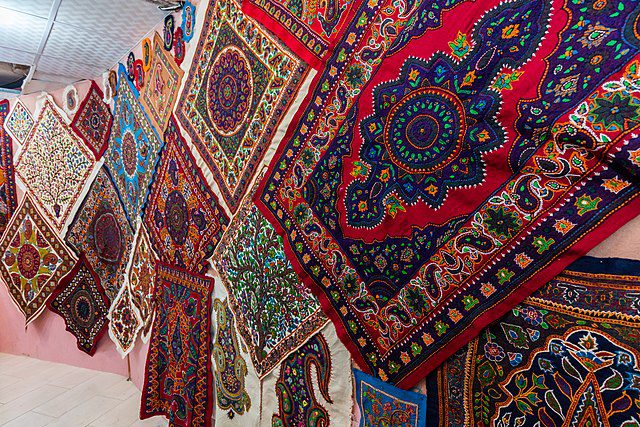
Carpet and rug weaving is one of the main industries of the city, and the carpets produced there are well-known worldwide. Carpet weaving is a very old tradition here. The oldest carpet discovered here was about 500 years ago, which proves the precedence of weaving in this city. Cashmere, Shore napped, coarse, and cotton textiles and goats-wool shawls are also manufactured in namely region.
A number of modern establishments such as textile mills and brickworks also been constructed. The province is rich in minerals including copper and coal. As mentioned above, pistachios of Kerman and Rafsanjan are at the top of the main products of this province.
Kerman Grand Bazaar: A Historic Treasure
The Kerman Grand Bazaar, also known as National Bazaar or Vakil Bazaar, stands as Iran’s second oldest bazaar, second only to Tabriz Bazaar. Stretching approximately 1.5 kilometers, it commences at Arg Square and gracefully unfolds until it reaches Mushtaqieh Square. This eighth-century AH time capsule offers a unique historical journey into the heart of this city, allowing you to immerse yourself in the city’s culture, people, and prized souvenirs, notably the fragrant cumin, whose aroma envelopes you as you wander through the market.
Don’t miss the allure of the Gold Passage within the grand bazaar, and be sure to explore the Copper Passage in the Ganjali Khan Complex. If you find yourself with extra time, take a moment to relax at the Vakil Bath, transformed into a charming teahouse. Alternatively, delve into the rich history of the region at the Ganjali Khan Bath, now a captivating anthropological museum. This Grand Bazaar is more than a market; it’s a gateway to the city’s soul and a sensory journey through time and tradition.
Top Attractions of Kerman
Kerman City is a treasure trove of attractions that suits every taste and age group. A visit here is as delightful as a desert breeze and as flavorful as the scent of this city’s famous cumin. In this series, we’ll uncover the top attractions of the city, ensuring your trip is truly special.
Shahzadeh Mahan Garden

In Kerman, Shahzadeh Garden is a must-visit. This lush oasis from the Qajar era sprawls over 3 hectares and boasts a unique entrance. Filled with tall trees, serene ponds, bubbling fountains, and meandering streams, it’s a delightful spot to explore. Just a short 30-minute drive from the city, it welcomes visitors daily from 9 a.m. to 12:30 p.m. and again from 3 p.m. to 6 p.m. But remember, it’s always wise to double-check the hours before setting off on your adventure!
Shahzadeh Garden, a testament to the Qajar era’s architectural beauty, invites travelers to its wonder. This sprawling 3-hectare oasis stands out with its striking entrance and abundant greenery. Tall trees, tranquil ponds, dancing fountains, and meandering streams breathe life into the landscape. Situated just a short 30-minute drive from the city, it’s open daily from 9 a.m. to 12:30 p.m. and then from 3 p.m. to 6 p.m. However, it’s always a good idea to confirm the visiting hours before embarking on your journey.
Bam Citadel
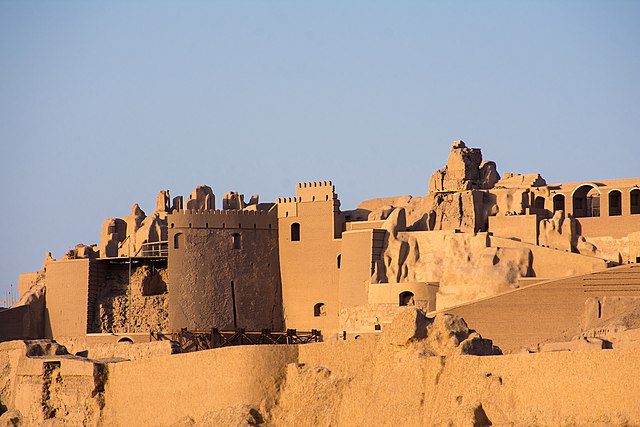
The Bam Citadel stands as a testament to human resilience and architectural wonder. It proudly holds the title of the world’s largest adobe building and has earned its place on UNESCO’s prestigious World Heritage List. However, its illustrious history was marred by the devastating Bam earthquake in 2003, which left it in ruins and endangered its UNESCO status.
But the story doesn’t end there. For over a decade and a half, relentless efforts have breathed new life into this magnificent structure. Thanks to unwavering dedication, the Bam Citadel has been lovingly restored, once again becoming a magnetic attraction for tourists eager to witness its grandeur.
Located in the heart of Bam city, just a scenic two-hour drive from Kerman, this historic gem beckons travelers from far and wide to witness its remarkable revival and stand in awe of its enduring splendor.
Ganjali Khan Complex
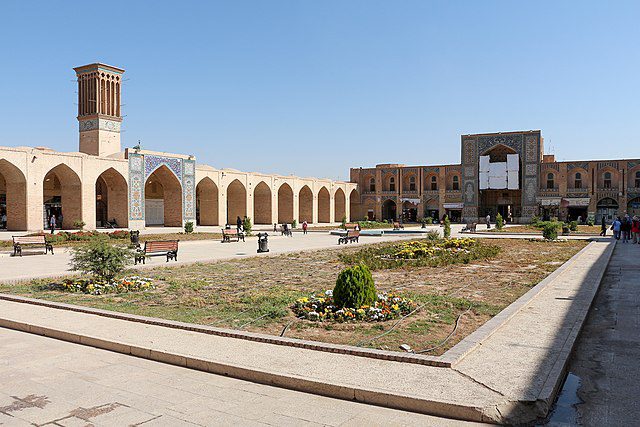
In the heart of Kerman, right near the bustling Grand Bazaar, you’ll find the Ganjali Khan Complex—a place brimming with history. This special spot houses several interesting places: to the south, there’s the Anthropology Museum in the Ganjali Khan Bath, and to the north, you’ll discover the Ganjali Khan Coin Museum. The east side holds the Ganjali Khan Caravanserai and School, while the west features the Ab Anbar, an old water reservoir. The Ganjali Khan Bazaar surrounds the complex on three sides.
Built during the Safavid era under the orders of Ganjali Khan, a ruler during Shah Abbas’s time, this complex boasts an Isfahani architectural style. To find it, just make your way from Shariati Street to Tohid Square, and finally, follow Khorram Street. There, you’ll uncover the Grand Bazaar and the intriguing Ganjali Khan Complex, where history and heritage come to life.
Kerman Harandi Garden
The Harandi Garden Museum in Kerman, also known as the Harandi Museum, has a fascinating past. This beautiful garden contains a grand mansion with an interesting story. It was built around 1873 as a peaceful retreat on the outskirts of the city, originally owned by a notable figure named “Mohammad Reza Khan Adl Sultan,” who was a famous local soldier.
After some years, the property changed hands and was sold to Abolghasem Harandi, a well-known merchant. About 40 years later, Harandi generously donated the garden to the Ministry of Culture and Arts, making it accessible to the public. Over time, this lush garden has seen many changes, serving as a museum at one point and later becoming the offices of the Cultural Heritage and Tourism Organization.
Today, you can find the Harandi Garden Museum on Ferdowsi Street in Kerman. The mansion’s ground floor now houses a Museum of Traditional Instruments, while the first floor has been transformed into an Archaeological Museum. It’s a place where history and culture come alive, offering a glimpse into this city’s rich heritage.
Jabaliyeh Historical Dome

In Kerman, the Jabalieh Dome is a unique stone building, now the Stone Museum, and it stands alone in the city. What makes it fascinating is its mysterious history. Some think it might have links to ancient Iran, possibly as a fire temple or the tomb of a Zoroastrian leader called “Gabri,” later named “Jabaliya.” Another theory places it in the Seljuk period, but that’s uncertain.
What’s intriguing is that the dome’s architecture differs from typical fire temples. Additionally, historical clues hint that camel milk, not water, might have been used in its construction. This enigmatic structure resides in the eastern part of the city, at the crossroads of Shohada Street and Ghaem Boulevard, inviting you to explore its secrets and rich history.
Kerman Jameh Mosque

Jameh Mosque, also known as the Mozaffari Mosque, graces Kerman with its majestic presence. You’ll find it proudly standing near Shohada Square, nestled on Shariati Street, snugly positioned between Ghadmagah and Mozaffari Bazaars. This mosque, with its rich history, is a treasure trove of architectural wonders dating back to the Muzaffarid era.
What truly sets this mosque apart are its four Iwans, architectural elements that create a grand entrance feel. The eastern entrance, in particular, stands tall and magnificent, leaving a lasting impression on all who visit. Inside, the tiled mosaic Mihrab adds a touch of exquisite beauty and is among the most renowned features of this splendid landmark. Jameh Mosque is not just a place of worship; it’s a living testament to the city’s rich cultural heritage and architectural prowess.
Shahdad Kaluts
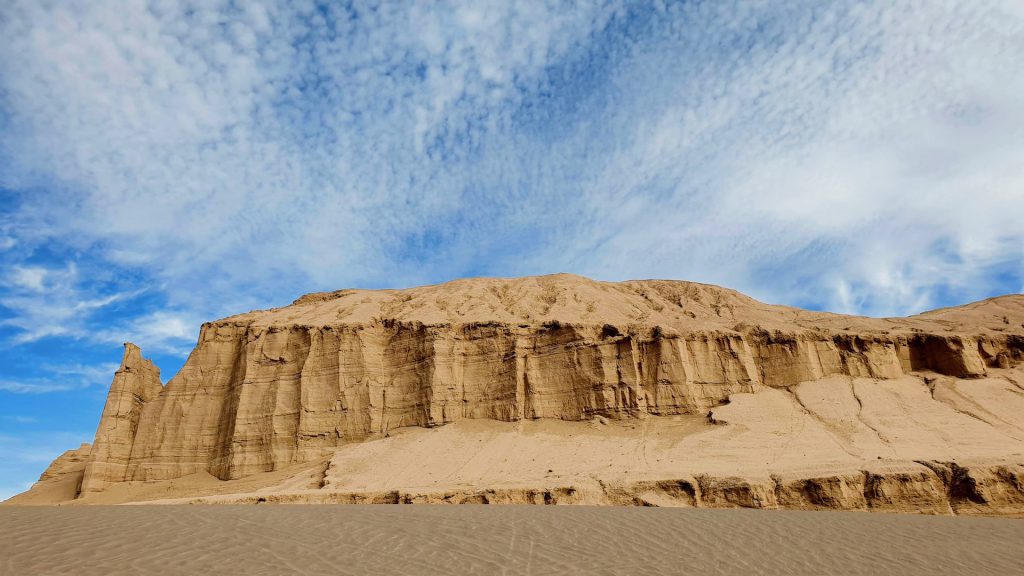
Along the edges of the Lut Desert, nature has sculpted awe-inspiring formations known as Kaluts through relentless erosion. To witness their breathtaking beauty, there’s no better time than sunrise and sunset when the desert’s vibrant colors come to life, painting a mesmerizing canvas on these towering structures.
Moreover, nestled within the heart of the Lut Desert lies the hottest spot on Earth. Hence, the cooler temperatures during sunrise and sunset offer a more comfortable and suitable window for exploring the captivating Kaluts, ensuring that your visit is both visually stunning and thermally bearable.
Shah Nematollah Vali Shrine
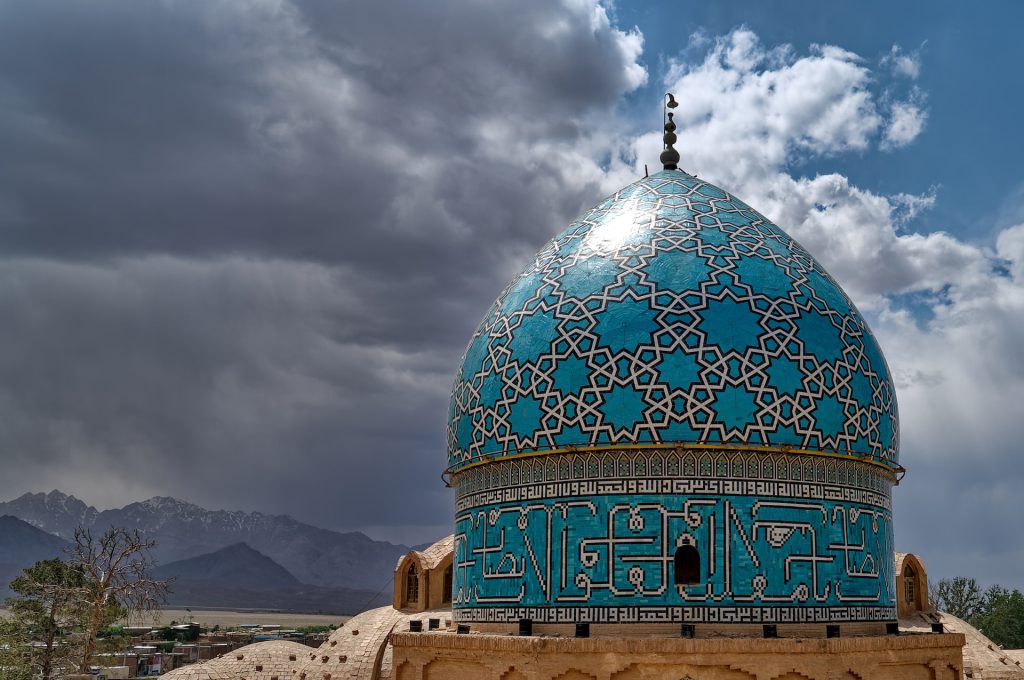
Nestled in the city of Mahan, just a stone’s throw away from Kerman lies the tranquil Shrine of Shah Nematullah Vali. This sacred site has flourished over the years, expanding to encompass an impressive area of over 3,000 square meters and its surrounding grounds.
Here, amidst the serenity of Mahan, visitors can connect with the rich spiritual heritage of the region and find solace in the peaceful surroundings of this revered shrine.
Kerman Dokhtar Castle
Kerman’s Dokhtar Castle, also known by various names like Gavashir Castle, Old Castle, Mountain Castle, and Anahita Fire Temple, holds a storied past within its ancient walls. It proudly stands as one of Iran’s oldest castles, towering over the heart of this historic city. Interestingly, it now perches atop a high mountain to the east of the city, near Ardeshir Castle. What makes this castle all the more intriguing is its enigmatic history, as it remains largely unexplored by archaeologists.
Inside the castle, you’ll find a three-story semi-ruined building, a testament to its age and significance. The castle’s primary gateway is situated on the western side, while a staircase, once possibly connected to a movable bridge, leads further away from the gate. Dokhtar Castle stands as a silent sentinel, inviting curious minds to unlock its mysteries and connect with the ancient tales it holds within its weathered stones.
Rayen Citadel

In the southern reaches of Kerman lies the magnificent Rayen Citadel, a Persian marvel that stands as the third-largest adobe building globally, following in the footsteps of Bam Citadel and Morche Khort Citadel. Rooted in the Sassanid era, this architectural masterpiece pays homage to its ancient heritage.
The citadel’s general layout is a robust rectangular structure, encircled by formidable 10-meter-high walls, boasting four towers at each corner for added grandeur and defense. The castle’s splendid eastern entrance is the sole gateway, adorned with an imposing facade that captivates all who approach. Once inside this regal stronghold, you’ll uncover a world of royal and public residences, granaries, a school, and even a fire temple, painting a vivid picture of life in ancient Persia. Rayen Citadel is a testament to the enduring legacy of this remarkable region.
Cultural Landscape of Maymand
Nestled within the Iranian landscape, Meymand village, an esteemed UNESCO World Heritage Site, offers a captivating journey into an ancient way of life. While caves may evoke images of a bygone era, Meymand stands as a testament to the profound synergy of human craftsmanship and the awe-inspiring forces of nature.
What truly sets this village apart is its remarkable architecture, an art form that defies the conventional norms of construction. Here, homes weren’t built with bricks and stones meticulously assembled; instead, they were meticulously carved out of the very earth itself. The result is a stunning labyrinth of dwellings, each a unique masterpiece. These rocky abodes house the village’s resilient inhabitants, bearing witness to centuries of human existence, a place where history and the environment coexist in perfect harmony.

What truly distinguishes Meymand from other similar archaeological wonders is that it’s not merely a relic of the past; it’s a living, breathing village. Here, people continue to reside in the very homes carved by their ancestors over 12,000 years ago. It’s a living testament to the enduring spirit of human innovation, where the most minimal of resources have produced an extraordinary heritage. Meymand’s rocky dwellings have stood the test of time, demonstrating a remarkable resilience to both the scorching heat of summer and the biting cold of winter, thanks to their subterranean construction. Meymand is, without a doubt, a testament to the timeless ingenuity of human artistry, where the most modest of facilities have forged an extraordinary legacy that endures, nearly untouched by the ravages of time.
Kerman Travel Guide: How to Get to Kerman

When it comes to reaching the captivating city of Kerman, you’ll find a variety of transportation options to suit your travel preferences. Whether you prefer the thrill of a high-speed train ride, the flexibility of a road trip, or the convenience of air travel, this city offers access through all means of transportation. Here’s your travel guide:
By Plane
Kerman International Airport (IATA: KER – ICAO: OIKK) links you to big and small cities across Iran. Regular flights connect the city to Tehran (3-4 daily), Isfahan (1 weekly), Zahedan (1 weekly), Mashad (2 weekly), Kish Island (2 weekly), and Shiraz.
By Land: Bus, Car, and Train
Kerman’s Adineh Bus terminal, opened in 2013, makes bus travel easy. Highways connect the city to Tehran, Yazd (360 km), Zahedan, Bandar Abbas (600 km), Birjand, Shiraz (600 km), and Mashhad (920 km).
This city is part of Iran’s railway network, linking it to Tehran, Qom, Kashan, Yazd, Mashhad, and soon, Zahedan.
The Economical Twist: Ride-Sharing Apps
Save money with apps like SNAPP and TAP30 for cheaper rides than regular taxis. However, you choose to get here, Kerman’s diverse travel options set the stage for your unforgettable adventure.
Top Hotels in Kerman: The Best Accommodations
Choosing where to stay in Kerman is as important as exploring its historical and natural wonders. These five hotels each offer a unique charm, from luxurious ancient architecture to serene traditional caravanserais and cozy boutique options steeped in local culture. Get ready for a memorable stay in this captivating Iranian destination.
Hotel Pars Kerman
If you’re looking for a great place to stay in Kerman, Hotel Pars Kerman is a standout option beyond the city’s sole 5-star hotel. With 197 rooms across 8 floors, it caters to individuals and families, offering rooms for up to four guests.
This international hotel doesn’t skimp on amenities. It has live music, a kids’ playground, a barbershop, laundry services, a coffee shop, and even special rooms for guests with disabilities. Plus, you can rent a car to explore nearby attractions like Vakil Bath (5 km), Jabalieh Dome (9 km), and Shazdeh Garden (38 km). Hotel Pars ensures a comfortable and convenient stay for all.
Kerman Jahangardi Hotel
With 61 rooms on 2 floors, Kerman Jahangardi Hotel, part of Jahangardi Hotels Group, suits different budgets and tastes. It’s close to Ganjali Khan Complex and Grand Bazaar, just 5 km away.
This 4-star hotel offers convenience and fun with amenities like a lobby, elevator, library, and shopping store. There’s even a travel agency for adventures and safety measures like fire escapes and alarms.
For leisure, enjoy the Internet cafe, outdoor area, tennis court, gym, and billiards. They provide free parking for 40 cars and car rentals without drivers to explore the city at your own pace. Jahangardi Hotel combines comfort and entertainment for a great stay.
Golden Days Residence
If you’re after luxury, consider Golden Days Residence. It’s a 3-star hotel just 2 km from Kerman Vakil Bath, Ganjali Khan Complex, and Kerman Bazaar for souvenir shopping.
With six rooms and parking for five cars, it’s cozy yet convenient. Enjoy a game of billiards, dine at the rooftop restaurant, or relax in the coffee shop. Families will appreciate its kid-friendly policy: children under five stay free, and those aged 5-10 are half-price. Golden Days Residence offers both comfort and accessibility for your stay.
Eyvan Mahan Traditional Hotel
Eyvan Mahan Traditional Hotel is a cozy 3-star gem nestled in Mahan Town, a stone’s throw away from the renowned UNESCO World Heritage Site, Shazdeh Mahan Garden, just 4 kilometers down the road.
Staying at Eyvan Mahan Traditional Hotel offers you the unique opportunity to explore the city on foot. Immerse yourself in the warm and welcoming atmosphere of this city, where the locals greet you with genuine smiles. This hotel promises a delightful blend of comfort, tradition, and a chance to experience the heart of the city like a local.
Akhavan Hotel
For travelers seeking affordability in Kerman, Iran, Akhavan Hotel is a top pick. This 2-star hotel offers basic yet comfortable single and double rooms, perfect for individuals and couples. Inside, you’ll find a closet, fridge, furniture, and a telephone.
What makes it stand out? Location. It’s just a 5-minute walk to the bus stop and a quick 10-minute drive to the airport. Plus, many attractions are nearby, including the Sanati Contemporary Art Museum (2 km), Moayedi Icehouse (2 km), and Ganjali Khan Complex (3 km).
FAQs about Kerman, Iran
Q1: Where is Kerman, Iran?
A1: Kerman is situated along the southern-central edge of Iran’s Lut Desert, which is known as Kavir-e Lut.
Q2: What is Kerman in Iran famous for?
A2: Kerman is famous for its centuries-old art of hand-woven carpets, especially in the Maahani suburb.
Q3: What is the history of Kerman city?
A3: Kerman city, located in central south Iran, has a rich history dating back to the 3rd century A.D. It was founded by the Sassanid king, Ardashir I, and has been referred to by various names throughout history, including Ardashir Khoreh and Guasheer. The city was a vital cultural center during Islamic times and played a significant role in trade and carpet production during the Safavid Dynasty.
Q4: What is the climate like in Kerman?
A4: Kerman experiences two distinct climates – mild and dry in the north and scorching and hot in the south and southeast during the summer, while winter brings a cold climate.
Q5: Where can I find the best pistachios in Kerman?
A5: Kerman is known for producing premium pistachios due to its ideal climate and soil. You can find the best pistachios in the region’s vast pistachio orchards.
Q6: What language is Kerman Iran?
A6: The primary languages spoken in Kerman province are Persian and Garmsiri. Additionally, there are smaller linguistic communities that use languages such as Achomi, various Turkic dialects, and a dialect resembling Median spoken by the Jewish and Zoroastrian populations.
Q7: Is Kerman worth a visit?
A7: The ancient city of Kerman serves as the focal point for the expansive Kerman Province, situated in eastern Iran. This region boasts a diverse climate with four distinct seasons and is rich in natural, historical, and cultural treasures. Notably, it is home to the legacy of the Jiroft Culture, which has unveiled a fresh perspective on ancient world history.
Q8: What are the top attractions in Kerman?
A8: Some of the top attractions in Kerman include Shahzadeh Mahan Garden, Bam Citadel, Ganjali Khan Complex, Harandi Garden Museum, and Jabaliyeh Historical Dome.
Q9: How do I get to Kerman for my travel adventure?
A9: To get to Kerman, you have multiple options. You can take a flight to Kerman International Airport, use land transportation like buses and cars, or opt for the train. Additionally, ride-sharing apps like SNAPP and TAP30 offer economical alternatives for local travel within the city, making it convenient for your adventure.
Q10: What are the recommended hotels in Kerman?
A10: Recommended hotels in Kerman include Hotel Pars Kerman (5-star), Kerman Jahangardi Hotel (4-star), Golden Days Residence (3-star), Eyvan Mahan Traditional Hotel (3-star), and Akhavan Hotel (2-star) for various budgets and preferences.
Unlock the Best of Kerman with Customized Tours
If you’re planning to travel to Iran and experience Kerman, you’re in for a remarkable adventure. Kerman is steeped in history, culture, and natural beauty, offering a unique blend of experiences for travelers. To make the most of your journey, it’s highly recommended to opt for customized tours that cater to your specific interests and preferences. This is where To Iran Tour comes in.
At To Iran Tour, we’re not just tour operators; we’re your travel companions on a journey of discovery through the rich tapestry of Iran. Let us help you have a great experience in Iran by customizing your tour to your heart’s content. Get in touch with us today and embark on a remarkable adventure in Kerman, Iran, and beyond.



